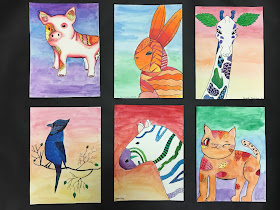Students began this unit by choosing a theme based on their "dream for the world": a hope or wish for our Earth's future that would better society. We took inspiration from Native American art, installation art, and repurposing techniques during the duration of this art unit. Students learned how to hand-dye their centerpieces and hanging pieces of their dreamcatchers after choosing a color scheme involving analogous colors (colors next to each other on the color wheel). They also learned to weave, knot, and bead. We also had a wonderful opportunity to hang our dreamcatcher installation at the Cooley Gallery in downtown, Leesburg. Please check out the photos below!
Sunday, April 30, 2017
Sunday, April 2, 2017
Clay Sculpture, Second Semester
Students learned about the three main hand-building techniques for clay sculpture: pinch pot, coil, and slab. Students were asked to create a sculpture (anything that they wanted!!!), that included all three hand-building techniques. After students finished sculpting, our sculptures were fired in my kiln. Then, students glazed their sculptures, and they were fired one more time to allow the glaze to turn to glass. Take a look at select 6th grade creations!
Wednesday, March 1, 2017
Artist Trading Cards, Second Semester, 2017
Since the beginning of the new semester, students have been working on a small collection of artist trading cards. Artist trading cards are miniature works of art that include subject matter of the students' choice. Students are also able to choose any medium in which to work when creating their mini artworks. Each student chose their favorite card to turn in for a grade. Below are photos of a class set from each block.
Block 2:
Block 3:
Block 4:
Block 5:
Block 6:
Block 7:
Block 2:
Block 3:
Block 4:
Block 5:
Block 6:
Block 7:
Thursday, February 23, 2017
Animal Zentagle Project, 2nd Semester 2017
Our first project for second semester was our Animal Zentangle project in our drawing unit. We learned about observational drawing, value, contour line, shape, and color. Students chose an animal (real or fantasy), and experimental with abstract line patterns called "zentangles". They used a minimum of 8 zentangle patterns in sections of their choosing. The animals were colored with colored pencil, while the background was painted with watercolor. Check out some of our results!





















